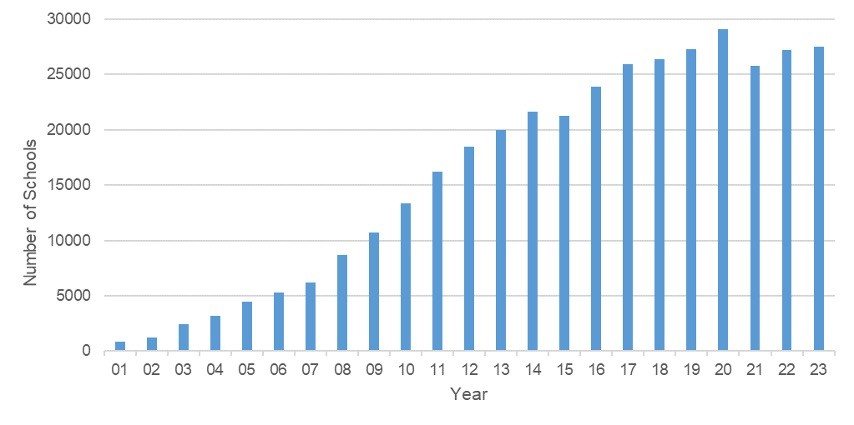Positive Behavioral Interventions and Supports (PBIS) is an evidence-based, tiered framework designed to support students’ behavioral, academic, social, emotional, and mental health. When implemented effectively, PBIS enhances social-emotional competence, academic success, and overall school climate. It also benefits teacher well-being by fostering positive, predictable, equitable, and safe learning environments for everyone. PBIS is used to refer to supporting all children and youth in any educational or therapeutic setting (e.g., K-12 school, early childhood program, treatment program, juvenile justice program).
PBIS implementation involves a commitment to systems change that supports students, educators, and families. When PBIS is implemented well, students experience improved behavioral, social, emotional, and academic outcomes. Schools also reduce their reliance on exclusionary discipline practices and foster a more positive school climate. Schools across the country have successfully implemented PBIS.
Key Characteristics of Schools Using PBIS
Schools implementing PBIS share several key characteristics:
- Employ a continuum of evidence-based practices to address student needs.
- Involve students, families, and community members in co-creating culturally responsive practices.
- Regularly evaluate the effectiveness of their practices.
- Utilize teams to guide implementation.
- Leverage data to identify strengths, address needs, and track student progress.
- Implement universal screening processes.
- Develop content expertise through coaching and ongoing professional development.
PBIS is not a curriculum or a one-time training program. It’s a continuous process of improving school systems to better support students and staff.
The Five Core Elements of PBIS
PBIS is built upon five interconnected elements: systems, data, practices, outcomes, and equity.
1. Systems
Systems are the foundational structures that support how schools and programs operate. These include teaming structures, training programs, coaching, and other resources for educators. In PBIS, these systems ensure the accurate and consistent implementation of practices and the effective use of data to achieve better outcomes.
When evaluating the systems supporting your PBIS framework, consider: What can we do to sustain our implementation over the long term?
2. Data
Schools and programs collect a wealth of data about their students daily. Within the PBIS framework, teams utilize this data to select, monitor, and evaluate outcomes, practices, and systems across all three tiers of support.
When considering the data available to you, ask yourself: What information do we need to make effective decisions about our PBIS implementation and outcomes?
3. Practices
The school and classroom practices you implement are crucial for supporting students and fostering a positive school climate. In PBIS, these interventions and strategies are research-backed and aligned with the outcomes you and your community aim to achieve.
When reflecting on the evidence-based practices you implement, consider: How will we support our students’ behavioral, social, emotional, and academic growth?
4. Outcomes
The ultimate goal of implementing PBIS data, systems, and practices is to improve outcomes for students, families, and educators. These outcomes might include improvements in behavioral, social, emotional, and academic areas, a more positive school climate, or a reduction in office discipline referrals.
When thinking about the outcomes you want to achieve, ask yourself: What is important to each of our communities?
5. Equity
When implemented with fidelity, PBIS seamlessly integrates into any school setting. This requires a focus on connectedness and belonging. Leadership teams collaborate with students, families, and community members to prioritize valued outcomes and promote high expectations for all students. Centering equity also involves supporting educators in their implementation roles, adapting practices to meet individual student needs, and analyzing data by student group to ensure equitable success for everyone.
When considering equity in your PBIS implementation, ask yourself: How can we enhance the experiences and outcomes of each educator and student?
The Tiered PBIS Framework
PBIS uses a tiered framework to provide academic, behavioral, social, and emotional support based on individual student needs. This continuum of support is structured across three tiers:
Tier 1: Universal, Primary Prevention (All)
Tier 1 systems, data, and practices support all students, educators, and staff across all school settings. They establish a foundation for positive and proactive support. Tier 1 support is comprehensive, differentiated, and designed to enable most (80% or more) students to succeed. Tier 1 practices include:
- Collaborating with students, families, and educators to define positive school-wide expectations and prioritize appropriate social, emotional, and behavioral skills.
- Aligning classroom expectations with school-wide expectations.
- Explicitly teaching expectations and skills to set all students up for success.
- Encouraging and acknowledging expected behavior.
- Preventing and responding to unwanted behavior in a respectful, instructional manner.
- Fostering school-family partnerships.
Tier 2: Targeted, Secondary Prevention (Some)
In addition to the Tier 1 foundation, students receiving Tier 2 supports receive an added layer of systems, data, and practices tailored to their specific needs. Typically, about 10-15% of students require some form of Tier 2 support. This support is more focused than Tier 1 and less intensive than Tier 3. Tier 2 practices include:
- Providing additional instruction and practice for behavioral, social, emotional, and academic skills.
- Increasing adult support and supervision.
- Providing additional opportunities for positive reinforcement.
- Increasing prompts or reminders.
- Increasing access to academic supports.
- Increasing school-family communication.
Tier 3: Intensive and Individualized, Tertiary Prevention (Few)
In most schools and programs, a small percentage (1-5%) of students require more intensive, individualized support than provided by Tier 1 and Tier 2 interventions. At Tier 3, students receive this intensive support to improve their outcomes. Tier 3 supports are available to any student with significant needs, regardless of whether they receive special education services. Tier 3 practices include:
- Engaging students, educators, and families in functional behavioral assessments and intervention planning.
- Coordinating support through wraparound and person-centered planning.
- Implementing individualized, comprehensive, and function-based support.
By implementing PBIS effectively, schools can create positive, safe, and equitable learning environments where all students can thrive.
